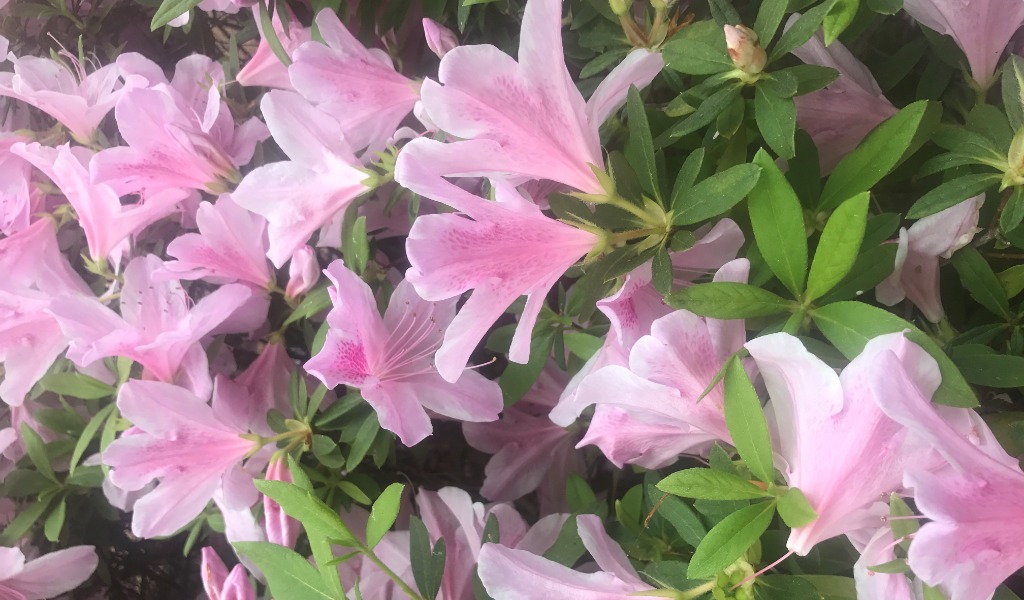Vibrant and surprisingly low maintenance, azaleas are ideal for brightening springtime gardens. These eye-catching shrubs thrive in humid environments, making them popular choices for Southern gardens.
In Houston, one of the city’s most popular springtime garden destinations is the Azalea Trail at the Bayou Bend Collection and Gardens. The sprawling garden, which surrounds a branch of the Museum of Fine Arts, Houston and is maintained by the River Oaks Garden Club, attracts avid gardeners, art lovers and those just looking for a casual open-air stroll, alike. The Azalea Trail features a wide range of varieties, many of which we see our customers ask to add to their own landscapes. As we head into spring, we’ve prepared a list of helpful tips and tricks for planting, growing and caring for these gorgeous flowers.
Types of Azaleas
There are hundreds of varieties of azaleas, including both evergreen and deciduous — meaning they shed their leaves during the fall — and they come in a wide range of colors. Each variety has its own set of needs, preferred growing conditions and specific look, but overall, these shrubs feature rich green foliage and brightly colored, large flowers. Below is a sampling of some of our favorite varieties, but we encourage you to explore the options available as you look for the right fit for your garden.
- George Taber: This elegant, lightly fragrant indica variety is often added to gardens for attracting butterflies with its soft magenta-hued flowers.
- Formosa: Another indica variety, Formosa azaleas feature gorgeous showy purple blooms
- Judge Solomon: This variety, known for its bright pink flowers, thrives in sunny environments making it an ideal choice for Houston gardens.
- G. G. Gerbing: This is an evergreen variety with huge showy white flowers that bloom during the spring season.
- Fashion: These dwarf azaleas bloom twice a year, in November or December and again in the spring.
When to Plant Azaleas in Houston
The best time of the year to plant azaleas is spring. However, they can also be planted with success in the fall or even late winter, in January and February. Azaleas do well in humid environments and many varieties can withstand the heat, making them ideal for Houston gardens. Most varieties also prefer sunlight and will bloom more fully in partially shaded areas that receive sunlight during the day. Shrubs that are planted in highly shaded areas will typically grow more slowly and have fewer flowers.
When to Fertilize Azaleas
It’s recommended to feed your azaleas immediately after they finish blooming and you’ve trimmed them. Azaleas often begin blooming in the spring and flower through midsummer. You may also choose to add a light fall feeding if they need an extra boost. Opt for a fertilizer designed specifically for azaleas and rhododendrons, when possible. An acidic, high-nitrogen and slow-release fertilizer is recommended in Houston for our neutral to alkaline soils.
How to Add Azaleas to Your Garden
Just as there are numerous azalea varieties, there are a myriad of ways to incorporate these plants into your landscape. Azaleas can be grown in perennial garden beds or containers. Dwarf varieties, which typically grow between 3 and 6 feet tall, are also popular choices for hedges and borders. It is important to note that while popular choices, azaleas are toxic to humans and animals, which may factor in to your choice of planting location.
If you’re ready to create your own personal azalea trail this spring, let us know. Our landscape architects and experienced maintenance crews can help you realize your vision, bringing cheer and vibrant colors to your garden.


